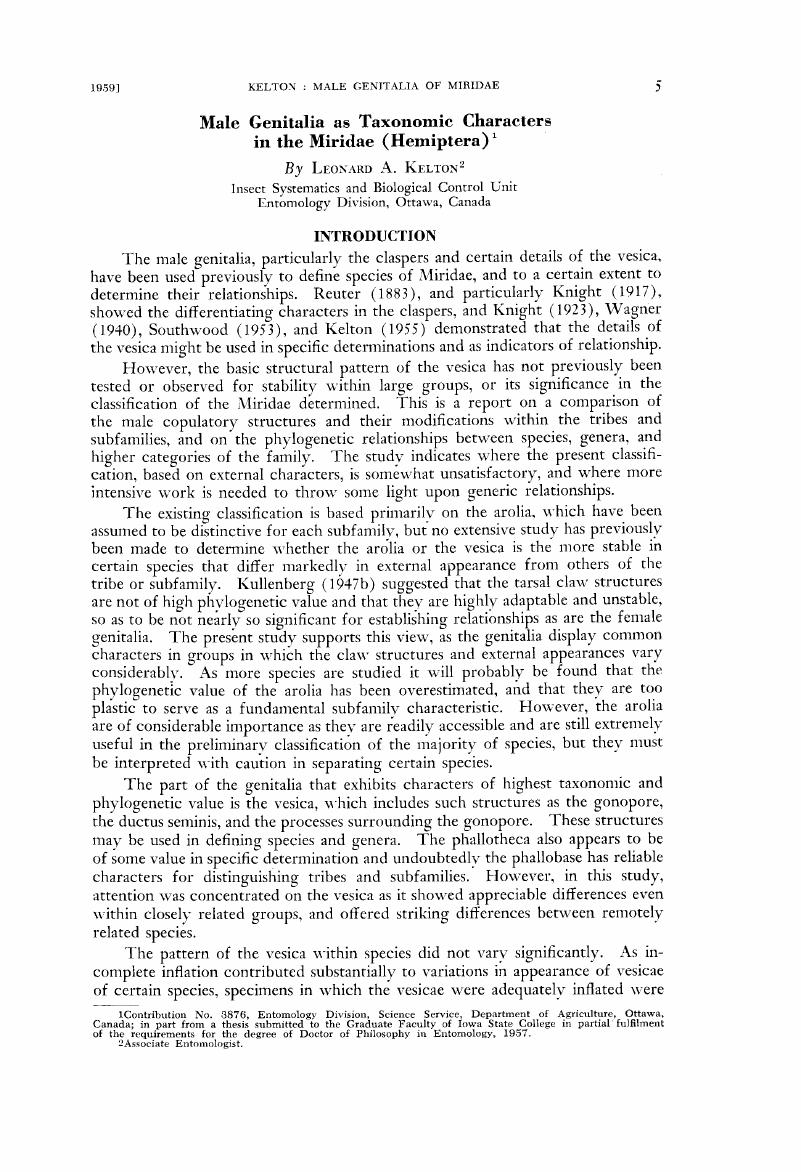Crossref Citations
This article has been cited by the following publications. This list is generated based on data provided by Crossref.
LESTON, DENNIS
1961.
TESTIS FOLLICLE NUMBER AND THE HIGHER SYSTEMATICS OF MIRIDAE (HEMIPTERA‐HETEROPTERA).
Proceedings of the Zoological Society of London,
Vol. 137,
Issue. 1,
p.
89.
Eyles, A. C.
1973.
PROTOMIRISTRANSFERRED TO ORTHOTYLINAE (HETEROPTERA : MIRIDAE).
New Zealand Entomologist,
Vol. 5,
Issue. 3,
p.
313.
Eyles, A.C.
1975.
Further new genera and other new combinations for species previously assigned toMegaloceroea(Heteroptera: Miridae: Stenodemini).
Journal of Natural History,
Vol. 9,
Issue. 2,
p.
153.
Eyles, A.C.
and
Carvalho, Jose C.M.
1975.
Revision of the genusDolichomiris, with a revised key to the genera of Stenodemini (Heteroptera: Miridae).
Journal of Natural History,
Vol. 9,
Issue. 3,
p.
257.
Eyles, A. C.
and
Carvalho, Joseé C. M.
1991.
Revision of the genusChinamirisWoodward (Hempitera: Miridae).
New Zealand Journal of Zoology,
Vol. 18,
Issue. 3,
p.
267.
Stonedahl, Gary M.
1991.
The Oriental species ofHelopeltis(Heteroptera: Miridae): a review of economic literature and guide to identification.
Bulletin of Entomological Research,
Vol. 81,
Issue. 4,
p.
465.
Lu, Nan
and
Zhang, Yuanlin
1994.
THE GENUS ALLORHINOCORIS REUTER FROM CHINA (HEMIPTERA: MIRIDAE).
Insect Science,
Vol. 1,
Issue. 3,
p.
205.
SCHUH, RANDALL T.
2000.
Revision of Oligotylus Van Duzee with Descriptions of Ten New Species from Western North America and Comments on Lepidargyrus in the Nearctic (Heteroptera: Miridae: Phylinae: Phylini).
American Museum Novitates,
Vol. 3300,
Issue. ,
p.
1.
Huber, Bernhard A.
Sinclair, Bradley J.
and
Schmitt, Michael
2007.
The evolution of asymmetric genitalia in spiders and insects.
Biological Reviews,
Vol. 82,
Issue. 4,
p.
647.
Konstantinov, F.V.
2007.
Male genitalia in Miridae: structure, terminology and application to phylogenetic inference. Critical comments on Cheng-Shing Lin & Chung-Tu Yang’s ideas (Heteroptera).
Zoosystematica Rossica,
Vol. 16,
Issue. 2,
p.
235.
Mróz, E.
and
Wojciechowski, W.
2011.
The systematic position of the tribe Stenodemini (Heteroptera: Cimicomorpha: Miridae: Mirinae) in the light of the male internal reproductive system.
Journal of Natural History,
Vol. 45,
Issue. 25-26,
p.
1563.
Cassis, G.
and
Schuh, R.T.
2012.
Systematics, Biodiversity, Biogeography, and Host Associations of the Miridae (Insecta: Hemiptera: Heteroptera: Cimicomorpha).
Annual Review of Entomology,
Vol. 57,
Issue. 1,
p.
377.
Jung, Sunghoon
and
Lee, Seunghwan
2012.
Molecular phylogeny of the plant bugs (Heteroptera: Miridae) and the evolution of feeding habits.
Cladistics,
Vol. 28,
Issue. 1,
p.
50.
Namyatova, A.A.
Schwartz, M.D.
and
Cassis, G.
2013.
First record of the genusStenotusJakovlev from Australia, with two new species, and a list of mirine species from Witchelina Nature Reserve (Insecta: Heteroptera: Miridae: Mirinae: Mirini).
Journal of Natural History,
Vol. 47,
Issue. 13-14,
p.
987.
Grazia, Jocélia
Simões, Felipe L.
and
Panizzi, Antônio R.
2015.
True Bugs (Heteroptera) of the Neotropics.
Vol. 2,
Issue. ,
p.
21.
NAMYATOVA, ANNA A.
KONSTANTINOV, FEDOR V.
and
CASSIS, GERASIMOS
2016.
Phylogeny and systematics of the subfamily Bryocorinae based on morphology with emphasis on the tribe Dicyphini sensu Schuh, .
Systematic Entomology,
Vol. 41,
Issue. 1,
p.
3.
Henry, Thomas J.
2018.
Revision of the Plant Bug Genus Semium (Heteroptera: Miridae: Phylinae: Semiini), with the Description of Three New Species and a Revised Key.
Proceedings of the Entomological Society of Washington,
Vol. 120,
Issue. 3,
p.
508.
Symonds, Celia L.
and
Cassis, Gerasimos
2018.
Systematics and Analysis of the Radiation of Orthotylini Plant Bugs Associated with Callitroid Conifers in Australia: Description of Five New Genera and 32 New Species (Heteroptera: Miridae: Orthotylinae).
Bulletin of the American Museum of Natural History,
Vol. 422,
Issue. 422,
p.
1.
Forero, Dimitri
Rodríguez, Juanita
and
Ocampo, Valentina
2018.
A new species of Carvalhomiris from Colombia with an assessment of its phylogenetic position (Heteroptera, Miridae, Orthotylinae).
ZooKeys,
Vol. 796,
Issue. ,
p.
197.
Kim, Junggon
and
Jung, Sunghoon
2019.
Phylogeny of the plant bug subfamily Mirinae (Hemiptera: Heteroptera: Cimicomorpha: Miridae) based on total evidence analysis.
Systematic Entomology,
Vol. 44,
Issue. 4,
p.
686.



